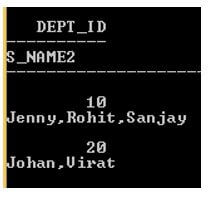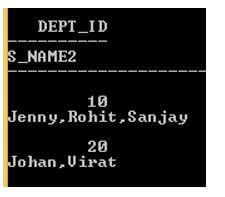Updated March 14, 2023
Introduction to RedShift listagg
Redshift provides different types of functionality to the user, in which listagg() is one of the functions that is provided by Redshift. Basically, listagg() is used to make the group according to user requirement, or we can say that according to order by expression. In other words, we can say that it is a single set aggregate function that means it works on all rows from the table and generates the single row as per our requirement, in which the data group it, and we specify the order by clause and then finally concatenate all data.
Syntax of RedShift listagg
Given below is the syntax mentioned:
select listagg (specified colm name [, ‘required delimiter’]) within group (order by clause[specified colm name]) from specified table name;
Explanation:
In the above syntax, we use the select clause and listagg() function with different parameters as follows:
- specified colm name: It is a specified column name or expression whose we need to concatenate together as final output. If it contains the null, then it is ignored.
- Required delimiter: It is an optional part of this syntax; basically, it is used to separate the value of the column as per requirement.
- group by: The group by is used to make the group of different rows.
- order by clause: It is used to determine the order of concatenated values.
How do listagg Work in Redshift?
- To link string esteems on Amazon Redshift information base, SQL engineers can utilize listagg SQL total capacity with a few contentions like comma separate person for getting a CSV list, or WithIn Group Order By proviso for arranging esteems inside the outcome rundown, or utilizing a Group By statement just as utilizing listagg work with Distinct condition.
- This SQL instructional exercise for Amazon Redshift information base engineers and chairmen will furnish test SQL codes with various utilizations of listagg string accumulation work.
- For a predetermined measure, listagg orders information inside each gathering determined in the ORDER BY proviso and afterwards links the upsides of the action segment. As a binary set total capacity, listagg works on all columns and returns a binary yield line. As a gathering set total, the capacity works on and returns a yield column for each gathering characterized by the GROUP BY statement.
- As an insightful capacity, listagg allotments the question result set into bunches dependent on at least one articulation in the query_partition_clause.
The contentions to the capacity are dependent upon the accompanying guidelines:
- The column name can be any articulation. Invalid qualities in the action section are disregarded.
- The delimiter assigns the string that is to isolate the action esteems. This proviso is discretionary and defaults to NULL.
- The order_by_clause decides the request where the connected qualities are returned. Thus, the capacity is deterministic just if the ORDER BY segment list accomplished exceptional requests.
- The return information type is RAW if the action section is RAW; in any case, the return esteem is VARCHAR2.
Examples of RedShift listagg
Given below are the examples of RedShift listagg:
Before implementation of the listagg() function, we need to create a table by using the following statement as follows:
Code:
create table s_dept(dept_id number(20), s_name varchar2(30), City varchar2(30));
Explanation:
- In the above example, we create table statements to create a new table name as s_dept with different attributes such as dept_id, s_name, and city with different data types.
- The final output, or we can say the results of the above statement, is illustrated by using the following screenshot.
Output:
Example #1
We need to insert some records into the newly created table by using insert into a statement as follows.
Code:
insert into s_dept(dept_id, s_name, City) values(10,'Jenny','Hongking');
insert into s_dept(dept_id, s_name, City) values(10,'Rohit','London');
insert into s_dept(dept_id, s_name, City) values(20,'Virat','Singpore');
insert into s_dept(dept_id, s_name, City) values(10,'Sanjay','Mumbai');
insert into s_dept(dept_id, s_name, City) values(20,'Johan','Pune');
Explanation:
- By using insert into the statement, we inserted some records.
- The final output, or we can say the results of the above statement, is illustrated by using the following screenshot.
Output:
Example #2
We can perform the listagg() function as follows.
Code:
select listagg(s_name, ',') within group (order by s_name) as s_name2 from s_dept;
Explanation:
- In the above example, we use the listagg() function to show all student names in a single row, and it is separated by using a comma, as shown in the above statement. In the above statement, we use the select with listagg() function; inside the bracket, we need to provide the column name with a delimiter.
- After that, we need to group and order by clause as per our requirement. Finally, the final output or we can say the results of the above statement, we illustrated by using the following screenshot as follows.
Output:
Example #3
Let’s see another example of the listagg() function as follows.
Code:
select dept_id, listagg(s_name, ',') within group (order by s_name) as s_name2 from s_dept group by dept_id;
Explanation:
- In this example, we try to implement the listagg() function; in the above statement, we use the select with listagg() function; inside the bracket, we need to provide the column name with a delimiter. After that, we need to group and order by clause as per our requirement.
- In this example, we show the student name with the department id, separated by using a comma as shown in the above statement. The final output or we can say results of the above statement, we illustrated by using the following screenshot as follows.
Output:
Example #4
Let’s see one more example of the listagg() function.
Code:
select dept_id, listagg(s_name, ',') within group (order by s_name) as s_name2 from s_dept group by dept_id order by dept_id;
Explanation:
- By using the above statement, we implement the listagg() function. In this example, we show the student name that belongs to each department, and it is ordered by dept_id as shown.
- The final output or we can say results of the above statement, we illustrated by using the following screenshot as follows.
Output:
Conclusion
From the above article, we have seen the basic syntax of the listagg function, and we also saw different examples of listagg function. From this article, we saw how and when we use the Redshift listagg function.
Recommended Articles
This is a guide to RedShift listagg. Here we discuss the introduction, how listagg work in Redshift? and examples, respectively. You may also have a look at the following articles to learn more –







